Aggregation Methods for Modelling Hydropower and Its Implications for a Highly Decarbonised Energy System in Europe
Abstract
:1. Introduction
1.1. Role of Hydropower in Future Power Systems
1.2. Implications for Power Market Models
1.3. Aggregation Methods in Power Market Models
1.4. Previous Work on Hydro System Aggregation
- formulating a single equivalent hydro system model representing the multireservoir system,
- determining the optimal operation of such a single equivalent hydro system model,
- disaggregating such optimal operation into the operation of the original multireservoir system.
1.5. Main Contributions
- bottom-up data base for hydropower systems across Europe comprising detailed hydro plant and reservoir information,
- natural inflow model relying only on basic prerequisite hydro reservoir data,
- novel equivalent hydro system model implementation including a possibility to integrate pumping capacity and adequate handling of multiple water paths (hydraulic coupling) by making use of an ex-ante optimisation,
- novel clustered equivalent hydro system model implementation employing k-means clustering,
- comparison and evaluation of both the equivalent and clustered equivalent hydro system model formulations with the detailed reference hydro system for a highly decarbonised power system scenario in Europe, in which flexibility is a key aspect.
2. Hydropower Data Base and Inflow Model
2.1. Hydro Reservoir and Plant Data
2.2. Hydro System Classification
2.3. Natural Inflow Model
3. Detailed Hydro System Model
3.1. Hydraulic Coupling
3.2. Detailed Model Formulation
4. Equivalent Hydro System Model
4.1. Assumptions
- The amount of electrical energy generated or consumed by any power plant i in period t is a constant times the discharge or intake, see Equations (7) and (8).
- The optimal operating policy of hydro system h is such that spillage will not occur in period t or will occur at every reservoir j of the hydro system h, and a shortage of water will not occur in period t or will occur in every reservoir j of the river.
4.2. Conversion Coefficients
4.3. Equivalent Model Types
4.4. Equivalent Model Formulation
5. Clustered Equivalent Hydro System Model
5.1. Clustering Criteria
5.2. Clustering Algorithm
5.3. Merging Clustered Units
6. Case Study
6.1. Scenario Description
6.2. Power Market Simulation
- Detailed (reference)
- Equivalent
- Clustered equivalent
6.3. Results
6.3.1. Energy Production and Consumption
6.3.2. Scheduling Decisions
6.3.3. Solution Time and Objective Value
7. Discussion
7.1. Limitations
7.2. Aggregation Effects
7.3. Performance of Aggregation Approach
8. Conclusions
Acknowledgments
Author Contributions
Conflicts of Interest
Nomenclature
| Abbreviations | |
| MAE | Mean Absolute Error |
| P | Pump of pumped-hydro storage plant |
| T | Turbine of conventional hydro storage and run-of-the-river plant |
| PT | Turbine of pumped-hydro storage plant |
| DS | Downstream |
| US | Upstream |
| CHP | Combined Heat and Power |
| PV | Photovoltaics |
| CCGT | Combined Cycle Gas Turbine |
| OCGT | Open Cycle Gas Turbine |
| General | |
| Cardinality of set A | |
| Relative complement of set A in B, | |
| Cubic hectometer | |
| Indices and sets | |
| Index and set of time steps (h) | |
| Index and set of hydro systems | |
| Index and set of hydro plants belonging to hydro system h | |
| Index and set of hydro plants with pump capacity belonging to hydro system h | |
| Index and set of hydro plants with pump turbine capacity belonging to hydro system h | |
| Index and set of hydro reservoirs belonging to hydro system h | |
| Index and set of pumped storage hydro reservoirs belonging to hydro system h | |
| Index and set of parallel plant connections belonging to hydro plant i of hydro system h | |
| Index and set of parallel plant connections belonging to hydro plant i with a connection to hydro reservoir j of hydro system h | |
| Parameters | |
| Water density () | |
| g | Gravity acceleration () |
| Net turbine head of hydro plant i of hydro system h (m) | |
| Net pump head of hydro plant i of hydro system h (m) | |
| Average turbine efficiency of hydro plant i of hydro system h (-) | |
| Average pump efficiency of hydro plant i of hydro system h (-) | |
| Equivalent pump conversion coefficient of hydro system h (-) | |
| Natural inflow of hydro reservoir j of hydro system h in time step t () | |
| Natural inflow of equivalent reservoir of hydro system h in time step t (MWh/h) | |
| Natural inflow of equivalent pumped hydro reservoir of hydro system h in time step t (MWh/h) | |
| System conservation coefficient of hydro reservoir j of hydro system h (-) | |
| Downstream path distribution coefficient for connection k of hydro plant i of hydro system h (-) | |
| Turbine energy equivalent coefficient for connection k of hydro plant i of hydro system h () | |
| Average turbine conversion coefficient for hydro reservoir j of hydro system h () | |
| Maximum conversion coefficient difference for hydro reservoir j of hydro system h () | |
| Pump energy equivalent coefficient for connection k of hydro plant i of hydro system h () | |
| Initial active storage volume of hydro reservoir j of hydro system h at beginning of the first time step () | |
| Final active storage volume of hydro reservoir j of hydro system h at end of the last time step () | |
| Minimum/maximum active storage volume of hydro reservoir j of hydro system h () | |
| Minimum/maximum active storage volume of equivalent hydro system h (MWh) | |
| Minimum/maximum active pumped storage volume of equivalent hydro system h (MWh) | |
| Minimum/maximum turbine generation capacity of hydro plant i of hydro system h (MWh/h) | |
| Minimum/maximum pump consumption capacity of hydro plant i of hydro system h (MWh/h) | |
| Minimum/maximum turbine generation capacity of equivalent hydro system h (MWh/h) | |
| Minimum/maximum pump consumption capacity of equivalent hydro system h (MWh/h) | |
| Minimum/maximum pump turbine consumption capacity of equivalent hydro system h (MWh/h) | |
| Decision variables | |
| Turbine generation of hydro plant i of hydro system h during time step t (MWh/h) | |
| Turbine generation of equivalent hydro system h during time step t (MWh/h) | |
| Pump turbine generation of equivalent hydro system h during time step t (MWh/h) | |
| Pump consumption of hydro plant i of hydro system h during time step t (MWh/h) | |
| Pump consumption of equivalent hydro system h during time step t (MWh/h) | |
| Active storage volume of hydro reservoir j of hydro system h at the beginning of time step t () | |
| Active storage volume of equivalent hydro system h at the beginning of time step t (MWh) | |
| Active pumped hydro storage volume of equivalent hydro system h at the beginning of time step t (MWh) | |
| Turbine discharge through connection k of hydro plant i of hydro system h during time step t () | |
| Pump discharge through connection k of hydro plant i of hydro system h during time step t () | |
| Spillage flow from hydro reservoir j to target reservoir of hydro system h during time step t () | |
| Spillage from equivalent reservoir of hydro system h during time step t (MWh/h) | |
| Spillage from equivalent pumped hydro reservoir of hydro system h during time step t (MWh/h) | |
| Clustering criteria | |
| Degree of regulation of equivalent hydro system h (-) | |
| Storage turbine ratio of equivalent hydro system h (h) | |
| Storage pump ratio of equivalent hydro system h (h) | |
Appendix A. Scenario Overview
| Market Area | Renewable Generation Capacity in GW | Thermal Generation Capacity in GW | Storage Capacity in GW | ||||||
|---|---|---|---|---|---|---|---|---|---|
| Wind Onshore | Wind Offshore | Solar PV | Natural Gas | Natural Gas | Natural Gas | Nuclear | Battery Storage | Power-to-Gas | |
| OCGT | CCGT | CHP-CCGT* | Steam Turbine | ||||||
| AUT | 9.6 | - | 46.2 | - | - | - | - | 0.8 | - |
| BEL | 4.8 | 6.0 | 48.4 | - | 6.5 | 4.9 | - | 3.1 | - |
| CHE | 2.0 | - | 53.6 | - | - | - | - | 4.1 | - |
| CZE | 23.9 | - | 26.3 | - | - | 4.0 | 1.9 | 0.2 | - |
| DEU | 112.3 | 31.9 | 192.4 | 3.3 | - | 22.2 | - | 6.6 | - |
| DNK | 16.0 | 6.0 | 6.1 | - | - | 1.8 | - | 0.5 | 2.2 |
| ESP | 91.5 | 0.7 | 121.2 | - | - | 3.8 | - | 6.8 | 4.3 |
| FIN | 18.2 | 6.0 | - | 0.5 | - | 3.6 | 1.6 | 0.6 | - |
| FRA | 158.4 | 2.0 | 156.0 | - | - | 11.1 | 7.6 | 9.2 | 7.7 |
| GBR | 76.7 | 38.3 | 177.6 | 2.2 | 5.8 | 17.7 | - | 18.8 | 5.1 |
| HUN | 7.1 | - | 8.9 | - | - | 1.2 | - | - | - |
| IRL | 10.2 | 3.9 | 13.0 | 0.3 | 0.4 | 2.0 | - | 1.3 | 2.1 |
| ITA | 63.8 | 0.7 | 204.9 | - | - | - | - | 27.6 | - |
| LUX | 0.7 | - | 3.8 | - | 2.9 | 0.2 | - | - | - |
| NLD | 20.6 | 14.5 | 58.5 | 0.7 | - | 6.8 | - | 6.0 | - |
| NOR | - | 5.0 | - | - | - | 0.7 | - | - | 0.7 |
| POL | 73.5 | 2.3 | 114.2 | 4.1 | 5.5 | 11.7 | - | 11.8 | 6.2 |
| PRT | 16.3 | - | 38.1 | - | - | 0.7 | - | 3.2 | 1.2 |
| SVK | 9.9 | - | 17.5 | - | - | 1.2 | 1.3 | - | - |
| SVN | 1.9 | - | 9.6 | - | 0.1 | 0.6 | - | - | - |
| SWE | 20.9 | 4.0 | - | - | - | 1.5 | - | - | - |
References
- Chen, D.; Leon, A.S.; Gibson, N.L.; Hosseini, P. Dimension reduction of decision variables for multireservoir operation: A spectral optimization model. Water Resour. Res. 2016, 52, 36–51. [Google Scholar] [CrossRef]
- Nandalal, K.D.W.; Bogárdi, J.J. Dynamic Programming Based Operation of Reservoirs: Applicability and Limits; International Hydrology Series; Cambridge University Press: Cambridge, UK, 2013. [Google Scholar]
- Rogers, D.F.; Plante, R.D.; Wong, R.T.; Evans, J.R. Aggregation and Disaggregation Techniques and Methodology in Optimization. Oper. Res. 1991, 39, 553–582. [Google Scholar] [CrossRef]
- Korpås, M.; Warland, L.; Tande, J.O.G.; Uhlen, K.; Purchala, K.; Wagemans, S. Further Developing Europe’s Power Market for Large Scale Integration of Wind Power: D3.2 Grid Modelling and Power System Data; Technical Report; TradeWind: Oslo, Norway, 2007. [Google Scholar]
- Christensen, G.S.; Soliman, S.A. Optimal Long-Term Operation of Electric Power Systems; Mathematical Concepts and Methods in Science and Engineering; Springer: Boston, MA, USA, 1988; Volume 38. [Google Scholar]
- Fosso, O.B.; Gjelsvik, A.; Haugstad, A.; Mo, B.; Wangensteen, I. Generation scheduling in a deregulated system. The Norwegian case. IEEE Trans. Power Syst. 1999, 14, 75–81. [Google Scholar] [CrossRef]
- Wolfgang, O.; Haugstad, A.; Mo, B.; Gjelsvik, A.; Wangensteen, I.; Doorman, G. Hydro reservoir handling in Norway before and after deregulation. Energy 2009, 34, 1642–1651. [Google Scholar] [CrossRef]
- Labadie, J.W. Optimal Operation of Multireservoir Systems: State-of-the-Art Review. J. Water Resour. Plan. Manag. 2004, 130, 93–111. [Google Scholar] [CrossRef]
- Brandão, J.L.B. Performance of the Equivalent Reservoir Modelling Technique for Multi-Reservoir Hydropower Systems. Water Resour. Manag. 2010, 24, 3101–3114. [Google Scholar] [CrossRef]
- Salas, J.D.; Hall, W.A.; Smith, R.A. Disaggregation and Aggregation of Water Systems. In Operation of Complex Water Systems; Guggino, E., Rossi, G., Hendricks, D., Eds.; Springer: Dordrecht, The Netherlands, 1983; pp. 35–60. [Google Scholar]
- Morlat, G. Sur La Consigne D’exploitation Optimum Des Réservoirs Saisonniers. La Houille Blanche 1951, 4, 497–510. [Google Scholar] [CrossRef]
- Arvanitidits, N.; Rosing, J. Composite Representation of a Multireservoir Hydroelectric Power System. IEEE Trans. Power Appar. Syst. 1970, PAS-89, 319–326. [Google Scholar] [CrossRef]
- Saad, M.; Turgeon, A.; Bigras, P.; Duquette, R. Learning disaggregation technique for the operation of long-term hydroelectric power systems. Water Resour. Res. 1994, 30, 3195–3202. [Google Scholar] [CrossRef]
- Hall, W.A. Optimal state dynamic programming for multireservoir hydroelectric systems; Class Notes; Colorado State University: Fort Collins, CO, USA, 1971. [Google Scholar]
- Turgeon, A. Optimal operation of multireservoir power systems with stochastic inflows. Water Resour. Res. 1980, 16, 275–283. [Google Scholar] [CrossRef]
- Valdés, J.B.; Filippo, J.D.; Strzepek, K.M.; Restrepo, P.J. Aggregation-disaggregation approach to multireservoir operation. J. Water Resour. Plan. Manag. 1992, 118, 423–444. [Google Scholar] [CrossRef]
- Kularathna, M.D.U.P. Application of Dynamic Programming for the Analysis of Complex Water Resources Systems: A Case Study on the Mahaweli River Basin Development in Sri Lanka. Ph.D. Thesis, Landbouwuniversiteit Wageningen, Wageningen, The Netherlands, 1992. [Google Scholar]
- Turgeon, A.; Charbonneau, R. An aggregation-disaggregation approach to long-term reservoir management. Water Resour. Res. 1998, 34, 3585–3594. [Google Scholar] [CrossRef]
- Söder, L. Two-station equivalent of hydro power systems. In Proceedings of the 15th Power Systems Computation Conference (PSCC), Liege, Belgium, 22–26 August 2005; pp. 1–7. [Google Scholar]
- Maceira, M.E.P.; Duarte, V.S.; Penna, D.D.J.; Tcheou, M.P. An approach to consider hydraulic coupled systems in the construction of equivalent reservoir model in hydrothermal operation planning. In Proceedings of the 17th Power Systems Computation Conference (PSCC), Stockholm, Sweden, 22–26 August 2011. [Google Scholar]
- Dereu, G.; Grellier, V. Latest Improvements of EDF Mid-Term Power Generation Management. In Handbook of Power Systems I; Rebennack, S., Pardalos, P.M., Pereira, M.V.F., Iliadis, N.A., Eds.; Springer: Berlin/Heidelberg, Germany, 2010; pp. 77–94. [Google Scholar]
- Bellman, R. E. Dynamic Programming; Princeton University Press: Princeton, NJ, USA, 1957. [Google Scholar]
- Pereira, M.V.F.; Pinto, L.M.V.G. Multi-stage stochastic optimization applied to energy planning. Math. Program. 1991, 52, 359–375. [Google Scholar]
- Gjerden, K.S.; Helseth, A.; Mo, B.; Warland, G. Hydrothermal scheduling in Norway using stochastic dual dynamic programming; a large-scale case study. In Proceedings of the 2015 IEEE Eindhoven PowerTech, Eindhoven, The Netherlands, 29 June–2 July 2015; pp. 1–6. [Google Scholar]
- Hecker, C.; Zauner, E.; Pellinger, C.; Carr, L.; Hötzl, S. Modellierung der flexiblen Energiebereitstellung von Wasserkraftwerken in Europa. In Proceedings of the 9th Internationale Energiewirtschaftstagung (IEWT), Vienna, Austria, 11–13 February 2015. [Google Scholar]
- Hirth, L. The benefits of flexibility: The value of wind energy with hydropower. Appl. Energy 2016, 181, 210–223. [Google Scholar] [CrossRef]
- Korpås, M.; Trötscher, T.; Völler, S.; Tande, J.O. Balancing of Wind Power Variations Using Norwegian Hydro Power. Wind Eng. 2013, 37, 79–95. [Google Scholar] [CrossRef]
- Rede Eléctrica Nacional. Hidroelectricidade em Portugal: Memória e desafio; Rede Eléctrica Nacional: Lisbon, Portugal, 2002. [Google Scholar]
- SSE. Booklet Power from the Glens; SSE: Perth, UK, 2012. [Google Scholar]
- Confederación Hidrográfica del Júcar. Parte Estado Embalses; Confederación Hidrográfica del Júcar: Valencia, Spain, 2017. [Google Scholar]
- Terna Group. Spreadsheet; Terna Group: Roma, Italy, 2011. [Google Scholar]
- Energiavirasto. Power Plant Register; Energiavirasto: Helsinki, Finland, 2017. [Google Scholar]
- Norges Vassdrags- og Energidirektorat. NVE Atlas; Norges Vassdrags- og Energidirektorat: Oslo, Norway, 2015. [Google Scholar]
- Bundesamt für Landestopografie Swisstopo. Swiss Geoportal; Bundesamt für Landestopografie Swisstopo: Bern, Switzerland, 2017. [Google Scholar]
- EDF. Carte de nos Implantations Industrielles en France; EDF: Paris, France, 2017. [Google Scholar]
- Electrabel GDF Suez. La Centrale D’accumulation Par Pompage de Coo—Trois-Ponts: Et Les Centrales Hydroélectriques du Sud-Est de la Belgique; Electrabel GDF Suez: Brussels, Belgium, 2012. [Google Scholar]
- First Hydro. First Hydro Power Stations; First Hydro: Caernarfon, UK, 2017. [Google Scholar]
- European Centre for Medium-Range Weather Forecasts (ECMWF). ERA Interim, Daily; European Centre for Medium-Range Weather Forecasts (ECMWF): Reading, UK, 2015. [Google Scholar]
- Dee, D.P.; Uppala, S.M.; Simmons, A.J.; Berrisford, P.; Poli, P.; Kobayashi, S.; Andrae, U.; Balmaseda, M.A.; Balsamo, G.; Bauer, P.; et al. The ERA-Interim reanalysis: Configuration and performance of the data assimilation system. Q. J. R. Meteorol. Soc. 2011, 137, 553–597. [Google Scholar] [CrossRef]
- Wangensteen, I. Power System Economics: The Nordic Electricity Market; Tapir Academic Press: Trondheim, Norway, 2007. [Google Scholar]
- MacQueen, J.B. Some methods for classification and analysis of multivariate observations. In Fifth Berkeley Symposium on Mathematical Statistics and Probability; Le Cam, L.M., Neyman, J., Eds.; University of California Press: Berkeley, CA, USA, 1967; Volume 1, pp. 281–297. [Google Scholar]
- Lloyd, S. Least squares quantization in PCM. IEEE Trans. Inf. Theory 1982, 28, 129–137. [Google Scholar] [CrossRef]
- Trost, T. Erneuerbare Mobilität im motorisierten Individualverkehr: Modellgestützte Szenarioanalyse der Marktdiffusion alternativer Fahrzeugantriebe und deren Auswirkungen auf das Energieversorgungssystem. Ph.D. Thesis, Universität Leipzig, Stuttgart, Germany, 2017. [Google Scholar]
- Gerhardt, N.; Böttger, D.; Trost, T.; Scholz, A.; Pape, C.; Gerlach, A.K.; Härtel, P.; Ganal, I. Analyse Eines Europäischen-95%-Klimazielszenarios über Mehrere Wetterjahre: Teilbericht; Technical Report; Fraunhofer IWES: Kassel, Germany, 2017. [Google Scholar]
- Deutscher Wetterdienst. Numerische Vorhersagemodelle: Regionalmodell COSMO-EU; Deutscher Wetterdienst: Offenbach, Germany, 2016. [Google Scholar]
- Capros, P.; de Vita, A.; Tasios, N.; Siskos, P.; Kannavou, M.; Petropoulos, A.; Evangelopoulou, S.; Zampara, M.; Papadopoulos, D.; Nakos, C. EU Reference Scenario 2016: Energy, Transport and GHG Emissions: Trends to 2050; Technical Report; European Commission: Brussels, Belgium, 2016. [Google Scholar]
- Von Oehsen, A. Entwicklung und Anwendung Einer Kraftwerks- und Speicherinsatzoptimierung für Die Untersuchung von Energieversorgungsszenarien mit Hohem Anteil Erneuerbarer Energien in Deutschland. Ph.D. Thesis, Universität Kassel, Kassel, Germany, 2012. [Google Scholar]
- Jentsch, M. Potenziale von Power-to-Gas Energiespeichern: Modellbasierte Analyse des Markt- und Netzseitigen Einsatzes im Zukünftigen Stromversorgungssystem. Ph.D. Thesis, Universität Kassel, Kassel, Germany, 2015. [Google Scholar]
- Anderski, T.; Surmann, Y.; Stemmer, S.; Grisey, N.; Momot, E.; Leger, A.C.; Betraoui, B.; van Roy, P. European Cluster Model of the Pan-European Transmission Grid: E-HIGHWAY 2050: Modular Development Plan of the Pan-European Transmission System 2050; Technical Report; e-Highway2050: Puteaux, France, 2014. [Google Scholar]
- Härtel, P.; Sandau, F. Aggregated modelling approach of power and heat sector coupling technologies in power system models. In Proceedings of the 14th International Conference on the European Energy Market (EEM), Dresden, Germany, 6–9 June 2017; pp. 1–6. [Google Scholar]
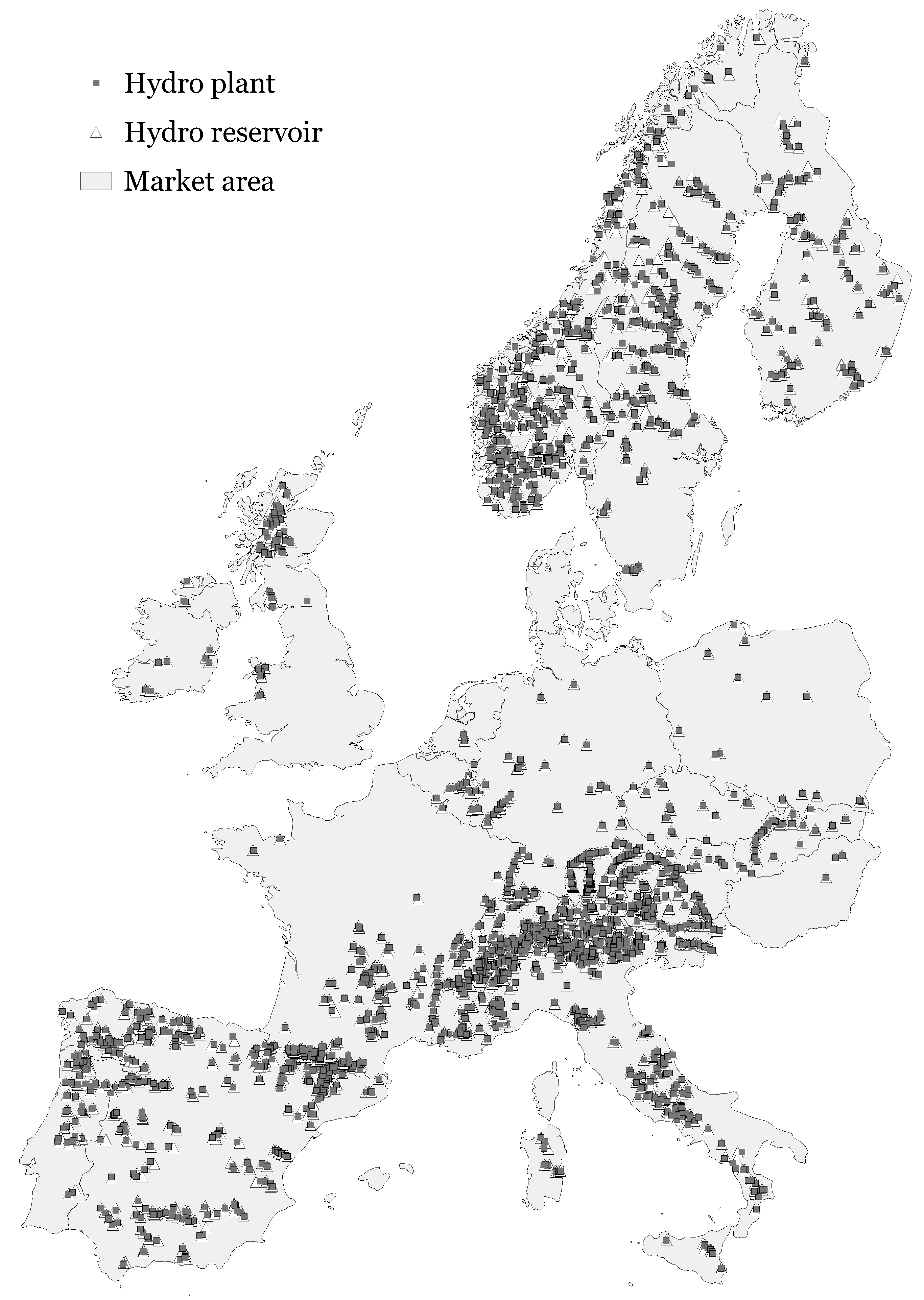
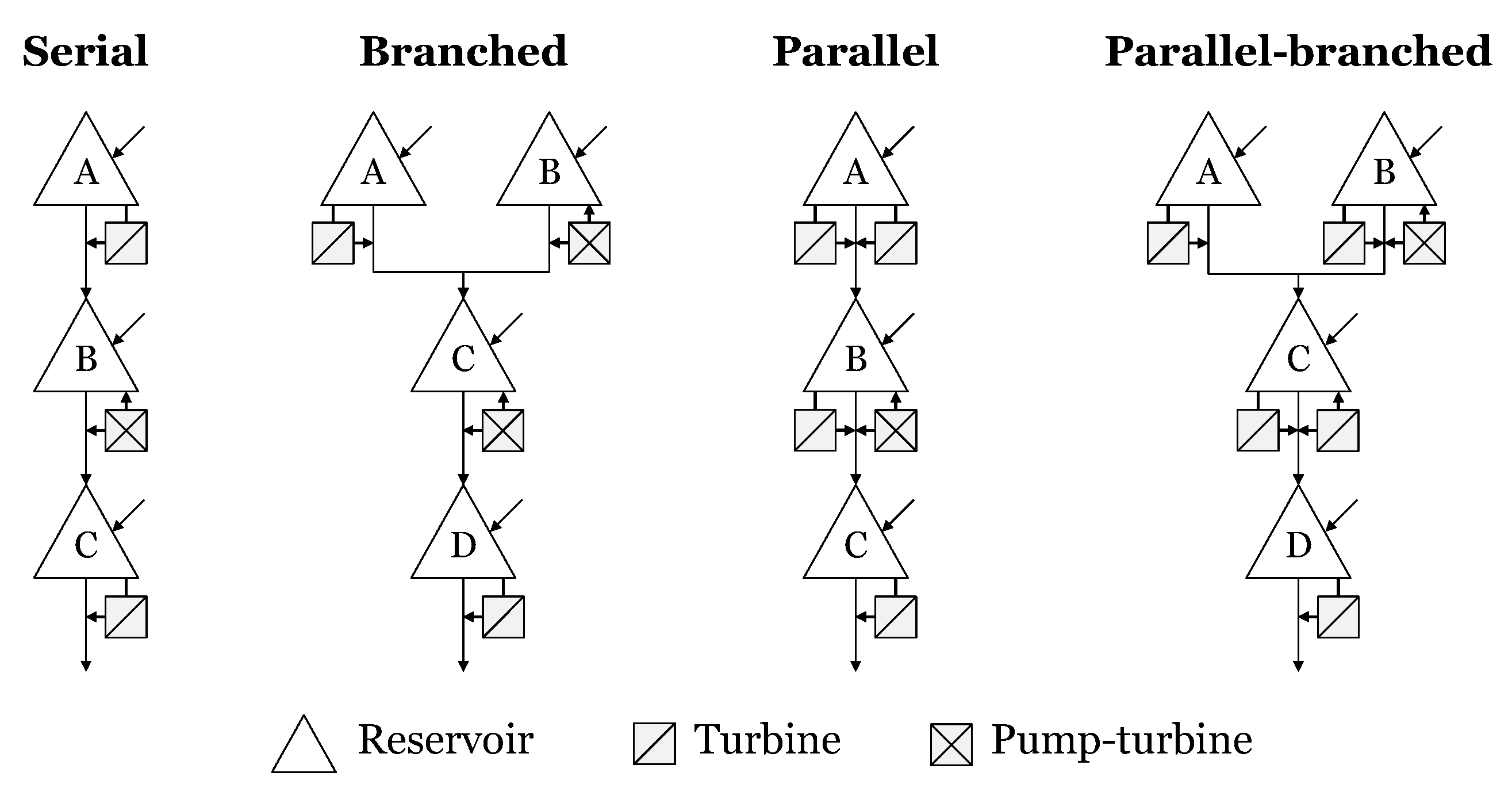

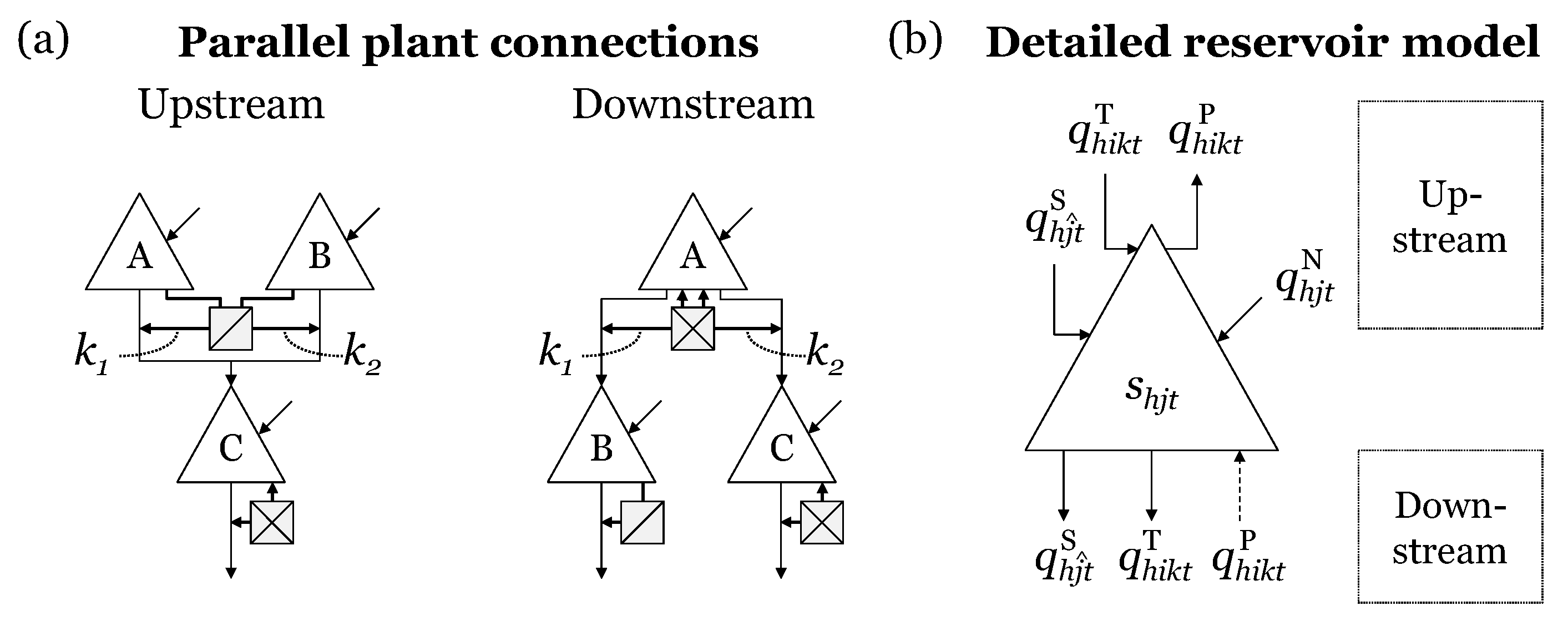



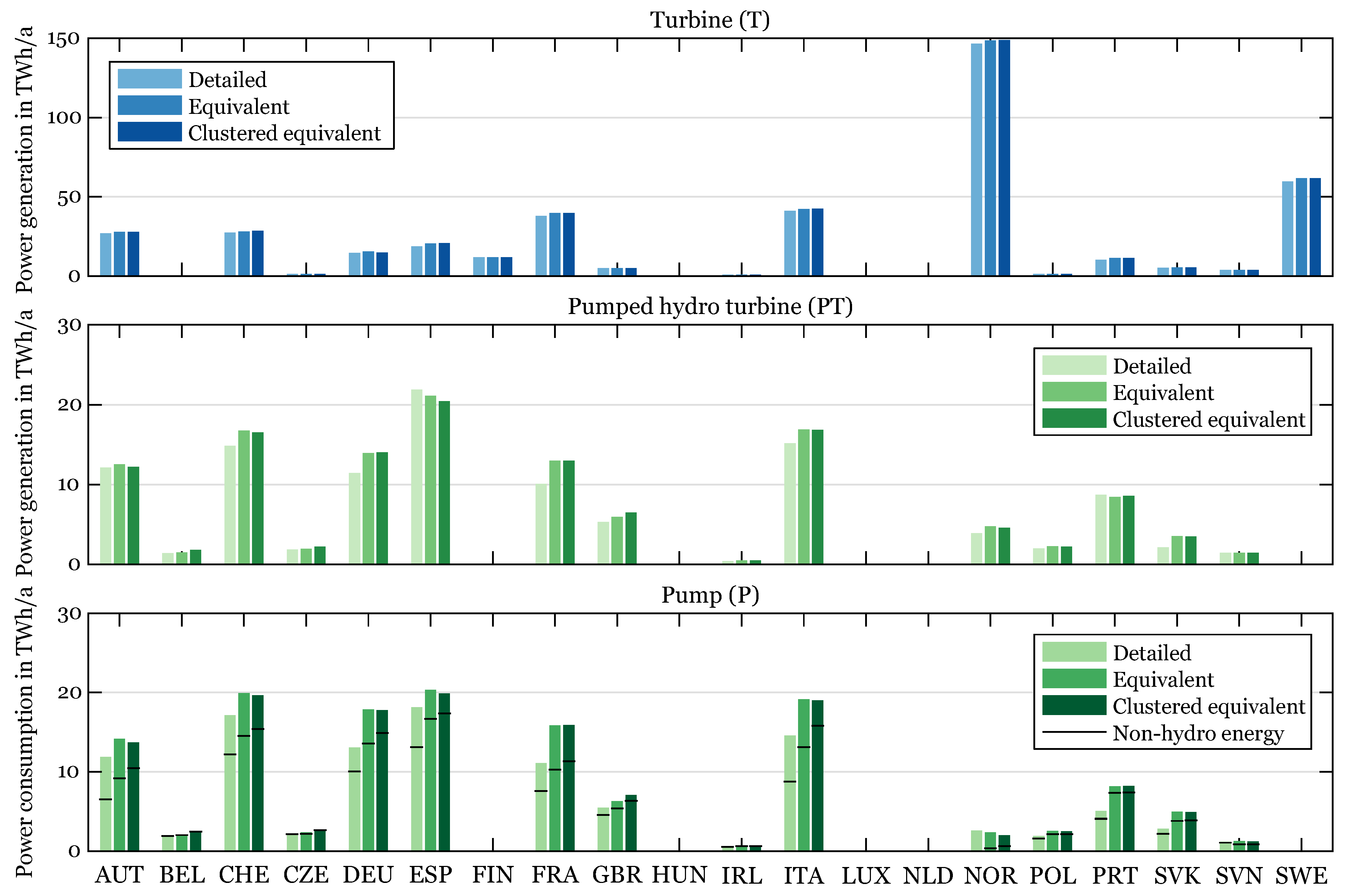
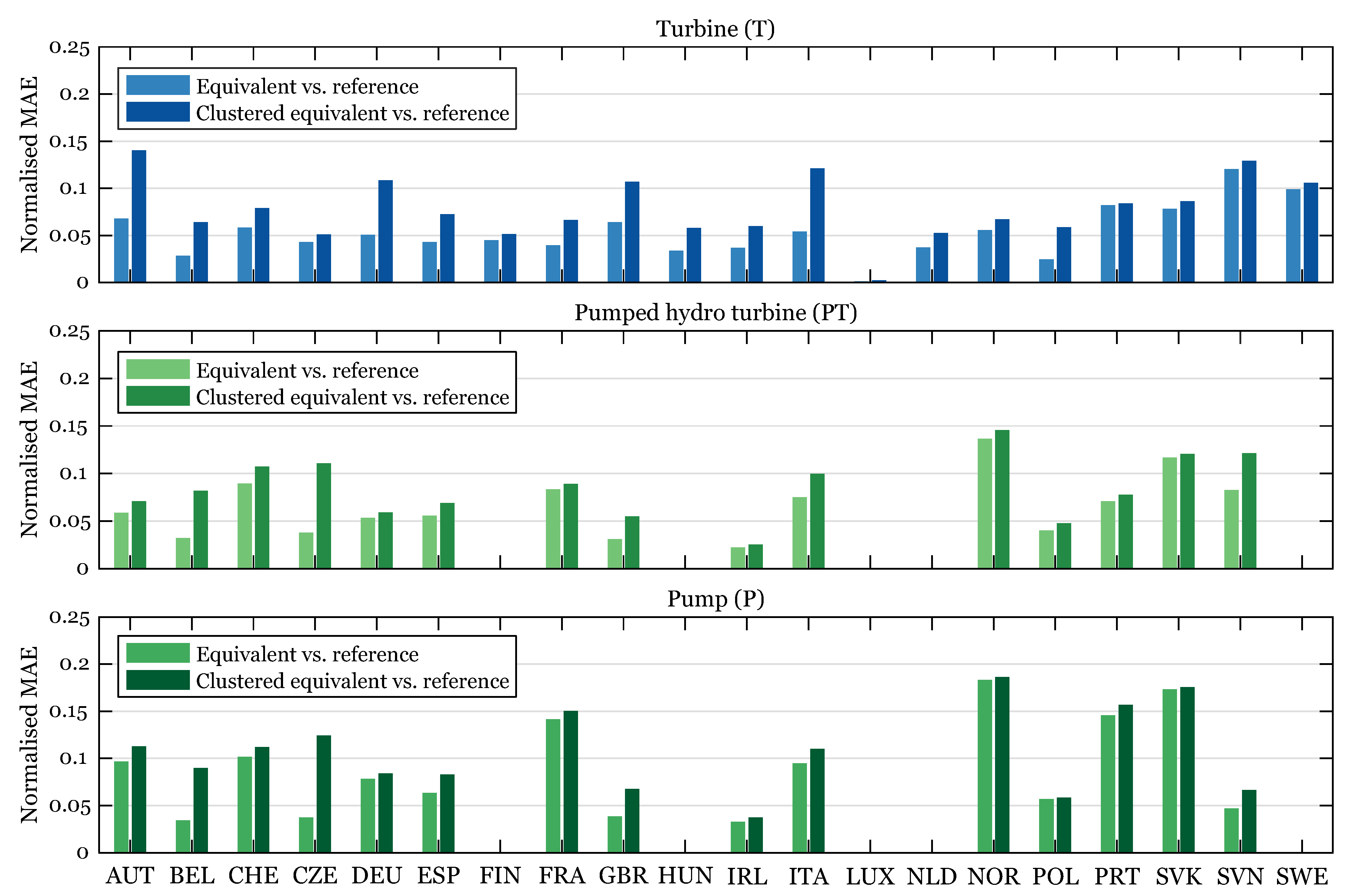
| Model Type | Inflow Pattern | |||
|---|---|---|---|---|
| Basic | • | • | • | - |
| Extended | • | • | • | • |
| Pump-only with inflow | • | • | • | • |
| Pump-only without inflow | - | - | • | • |
| Market Area | Total Capacity in GW | Total Storage Capacity in TWh | Number of | ||||||
|---|---|---|---|---|---|---|---|---|---|
| Turbine (T) | Pumped Hydro | Pump | Equivalent | Equivalent | Detailed | Detailed | Equivalent | Clustered eq. | |
| Turbine (PT) | (P) | Storage | Pumped Storage | Hydro Plants | Hydro Reservoirs | Hydro Systems | Hydro Systems | ||
| AUT | 8.32 | 5.54 | 4.49 | (3.21) | (1.02) | 176 | 236 | 61 | 14 |
| BEL | 0.11 | 1.30 | 1.20 | (0.02) | (0.01) | 13 | 24 | 11 | 3 |
| CHE | 12.30 | 6.50 | 5.51 | (10.12) | (2.10) | 153 | 207 | 68 | 16 |
| CZE | 1.09 | 1.15 | 1.13 | (0.34) | (0.03) | 23 | 38 | 15 | 6 |
| DEU | 4.67 | 10.12 | 8.88 | (0.48) | (0.11) | 150 | 185 | 40 | 9 |
| ESP | 11.44 | 10.81 | 9.19 | (17.58) | (3.60) | 405 | 458 | 94 | 18 |
| FIN | 3.23 | - | - | (5.22) | - | 113 | 133 | 27 | 7 |
| FRA | 18.11 | 6.08 | 4.82 | (8.53) | (0.74) | 296 | 358 | 56 | 14 |
| GBR | 1.34 | 4.14 | 3.90 | (1.41) | (0.08) | 64 | 88 | 22 | 12 |
| HUN | 0.07 | - | - | (<0.01) | - | 4 | 8 | 4 | 2 |
| IRL | 0.24 | 0.72 | 0.72 | (0.09) | (<0.01) | 14 | 24 | 10 | 6 |
| ITA | 15.87 | 6.84 | 6.87 | (11.63) | (0.32) | 484 | 608 | 137 | 15 |
| LUX | 0.05 | - | - | (<0.01) | (<0.01) * | 5 | 6 | 3 | 2 |
| NLD | 0.05 | - | - | (<0.01) | - | 5 | 10 | 5 | 2 |
| NOR | 30.51 | 1.37 | 1.04 | (82.41) | (2.36) | 382 | 500 | 120 | 20 |
| POL | 0.55 | 1.76 | 1.65 | (0.12) | (0.05) | 18 | 32 | 14 | 9 |
| PRT | 5.19 | 4.22 | 3.28 | (4.66) | (0.92) | 65 | 70 | 13 | 8 |
| SVK | 1.85 | 1.62 | 1.62 | (0.63) | (0.06) | 34 | 42 | 9 | 5 |
| SVN | 1.57 | 0.58 | 0.62 | (0.02) | (<0.01) | 35 | 37 | 4 | 2 |
| SWE | 16.34 | - | - | (32.16) | - | 221 | 243 | 21 | 7 |
| ALL | 132.90 | 62.74 | 54.89 | (178.64) | (11.42) | 2660 | 3307 | 734 | 177 |
| Model Variant | Solution Time | Objective Value | ||
|---|---|---|---|---|
| In h | % of Reference | In bn€ | % of Reference | |
| Detailed | 42.9 | 100.0 | 23.1 | 100.0 |
| Equivalent | 4.7 | 10.9 | 21.7 | 94.2 |
| Clustered equivalent | 0.5 | 1.3 | 21.2 | 92.0 |
© 2017 by the authors. Licensee MDPI, Basel, Switzerland. This article is an open access article distributed under the terms and conditions of the Creative Commons Attribution (CC BY) license (http://creativecommons.org/licenses/by/4.0/).
Share and Cite
Härtel, P.; Korpås, M. Aggregation Methods for Modelling Hydropower and Its Implications for a Highly Decarbonised Energy System in Europe. Energies 2017, 10, 1841. https://doi.org/10.3390/en10111841
Härtel P, Korpås M. Aggregation Methods for Modelling Hydropower and Its Implications for a Highly Decarbonised Energy System in Europe. Energies. 2017; 10(11):1841. https://doi.org/10.3390/en10111841
Chicago/Turabian StyleHärtel, Philipp, and Magnus Korpås. 2017. "Aggregation Methods for Modelling Hydropower and Its Implications for a Highly Decarbonised Energy System in Europe" Energies 10, no. 11: 1841. https://doi.org/10.3390/en10111841
APA StyleHärtel, P., & Korpås, M. (2017). Aggregation Methods for Modelling Hydropower and Its Implications for a Highly Decarbonised Energy System in Europe. Energies, 10(11), 1841. https://doi.org/10.3390/en10111841





